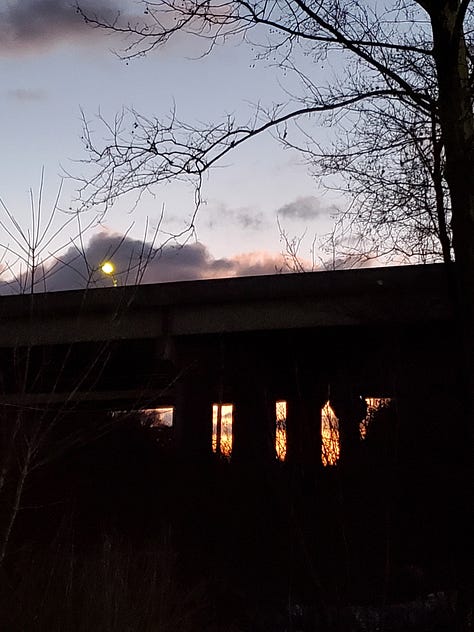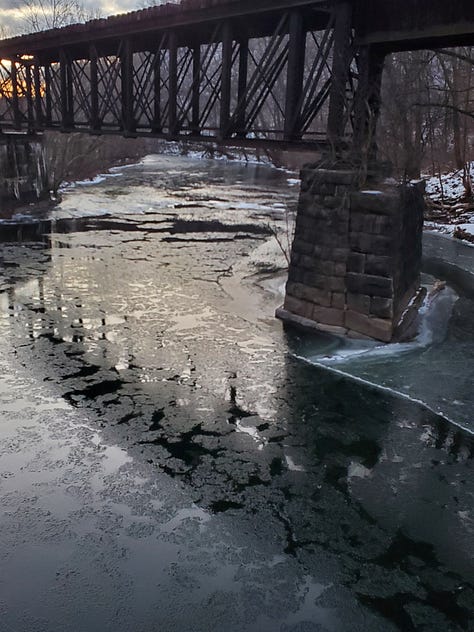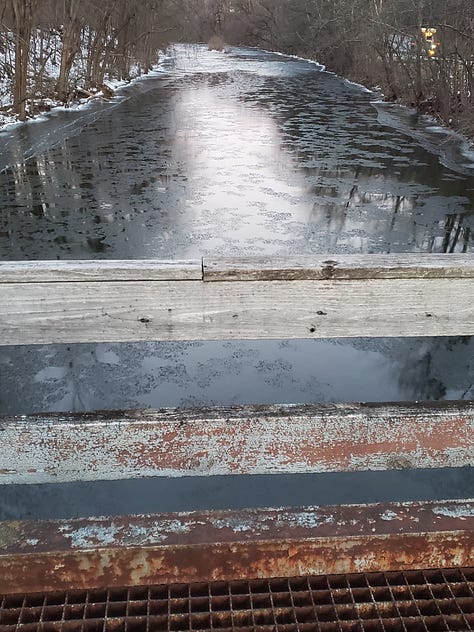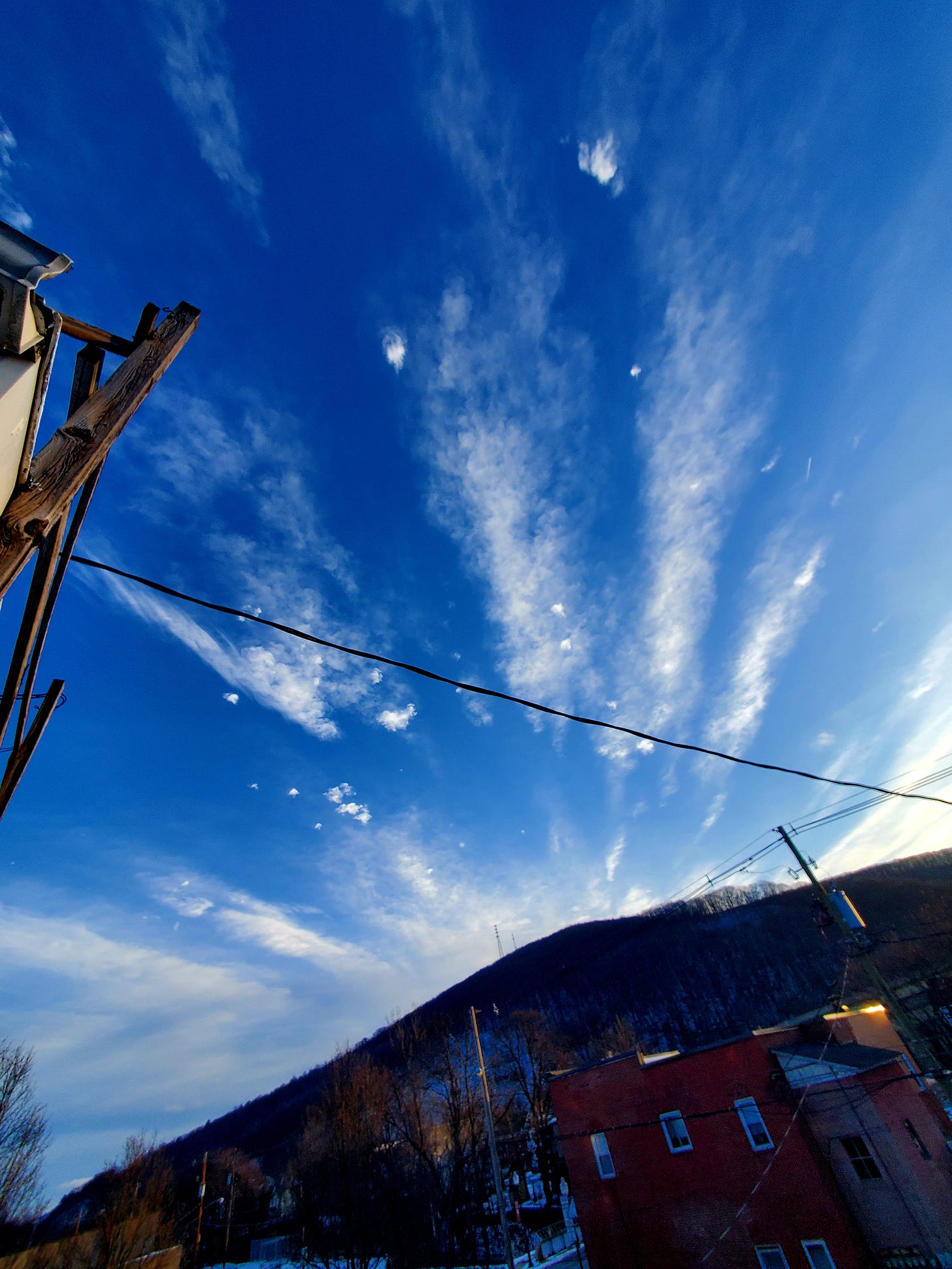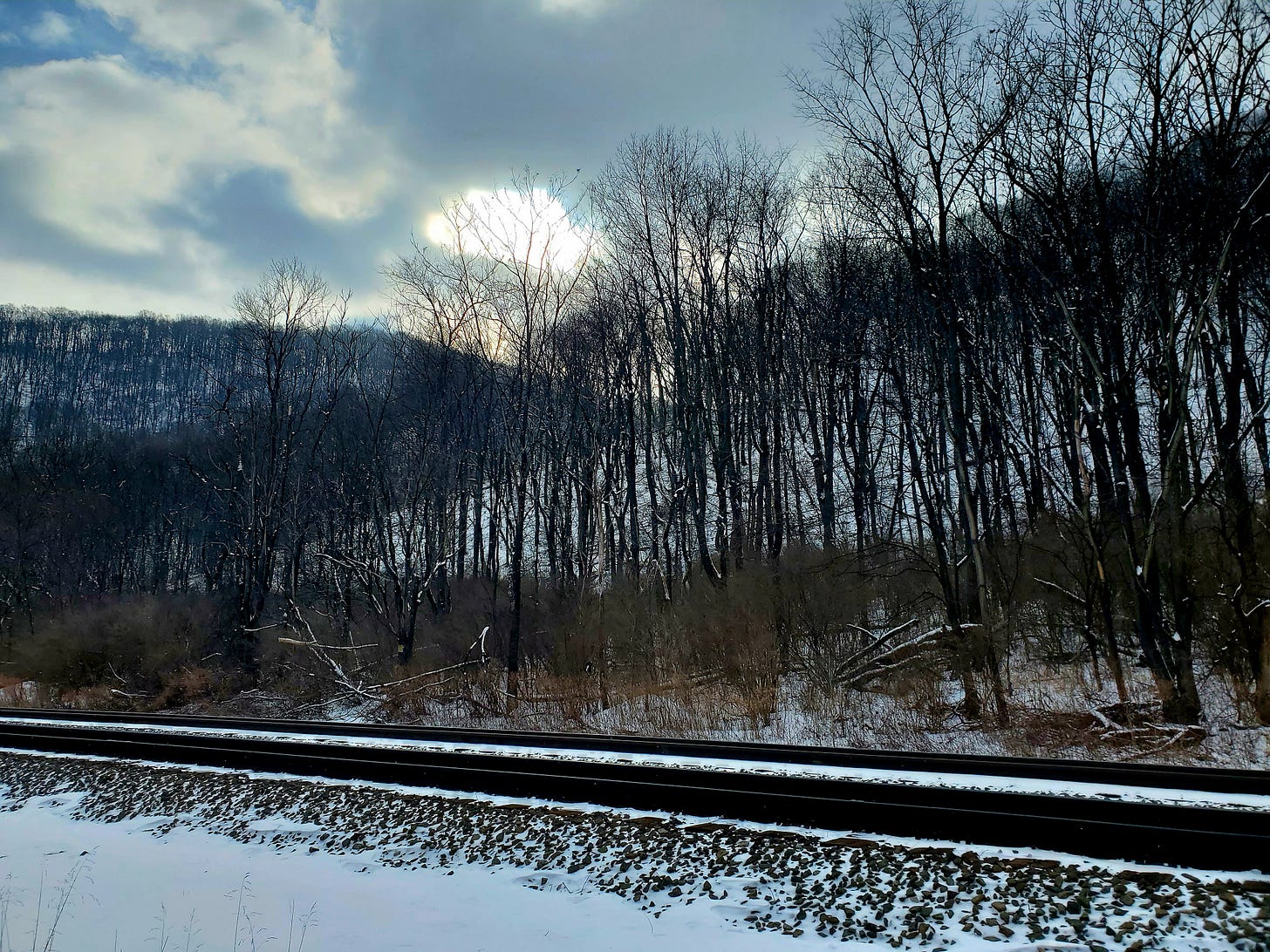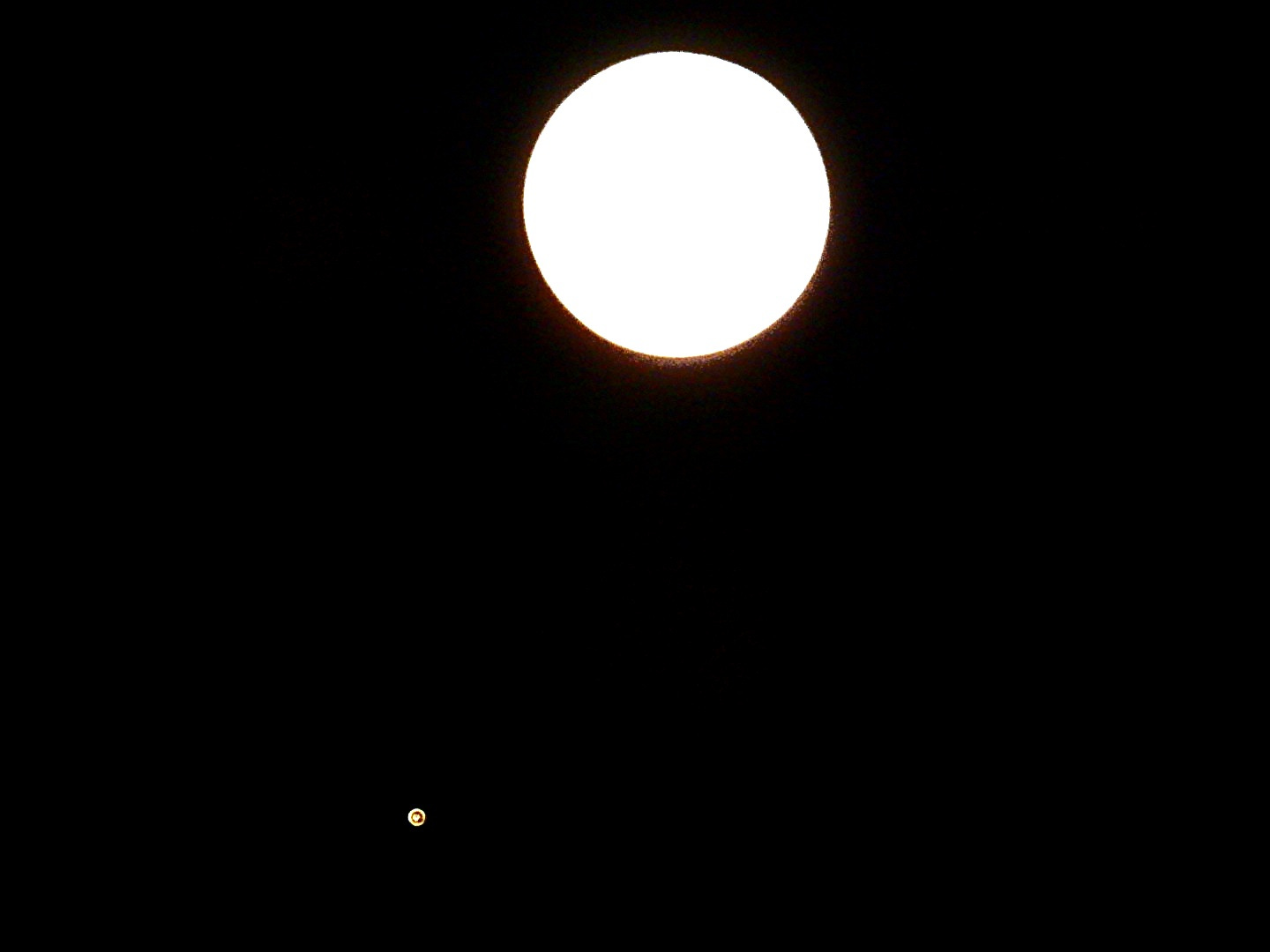Novus annum, novus avibus
New Year’s Day is rain and wind, and the first bird on my Plummer’s Hollow 2025 list is a Common Raven. From my balcony perch in downtown Tyrone, facing the river, rail, and interstate, I hear its mournful intonation in the distance at precisely 7:21 AM, from somewhere off beyond the train station. Unbeknownst to me, Eric’s PUC recorder already picked up a Common Goldeneye, first-ever for the hotspot, whizzing over not long after midnight, the staccato tone of its (their?) wingbeats rising and fading over a few seconds. Definitely a good sign for the year!
An American Tree Sparrow calls overhead, perhaps on its way to a feeder, as the blackness slowly ebbs. The solstice is long past and the afternoons are already growing longer, but we still have a few days until the mornings start to grow as well. Meanwhile, a scattering of locals awakes and before eight, a raven pair emerges into view, pirouetting across the Gap and up to the towers, croaking and moaning. Still later, a Cooper’s Hawk rustles what’s left of my hair as it speeds over the balcony. It lands briefly in a nearby poplar and then heads off to Pennsylvania Avenue.
Today, I’m rushing to chalk up some species prior to a brief trip to South Florida. Naturally, the 1st is the best day to catch any species that might have lingered from last year, but that’s a dim prospect this winter with the avifauna already thinned out. Nevertheless, I head out on the traditional 1/1 hike, first down the tracks as far as the pond, and then back up around the Hollow, delving into the densest patches of undergrowth on south-facing slopes where the most delicate southerners might be hiding.
The Little Juniata River is ice-free, with long and rather still stretches of water where waterfowl might come to float after the fully standing water bodies freeze up. I peek down through the trees from the height of the railroad right-of-way, in hopes of spotting the Horned Grebe that hung out for a few days here before Christmas. Instead, I’m rewarded with a close view of a shining black and white male Common Merganser, red bill glistening. It coasts by me downstream, and later, at the bridge, I flush it back upriver again.
Great Blue Herons, plural, are also around again—one at the bridge, and another downriver. They’ve been absent around here for around a month.
Winter Wrens are out in force, calling but not singing, while Carolina Wrens are singing, as they always do, regardless of season or weather. Brown Creepers are also about in the mixed passerine flocks along the river—they’re a species we missed during the Christmas Bird Count and another good add for 2025. The pond is, somehow, slightly open at the far end where the water comes in, enough space for 13 Mallards, which counts as a sizeable flock for this winter. Given January’s frozen prognosis, I can’t imagine the pond will be hospitable for much more than hibernating muskrats by the time we get back from the southland.
Up the Hollow I go, awash in the boring browns of an unwelcome winter thaw. The adelgid-plagued hemlock groves twitter with Black-capped Chickadees, Golden-crowned Kinglets, and other common winter residents in loose aggregations. They hunt for diminishing food among the scattered crowns of towering tulip-trees, loath to descend, while Dark-eyed Juncos scratch the open ground along the road and scatter up into thicker growth as I approach.
The best place in the hotspot for winter birds is the invasive-filled eastern slope of Sapsucker Ridge, and today does not disappoint. As soon as I head north off Dogwood Knoll, after ascending from the Hollow road, the barberries begin to hum and whistle with White-throated Sparrows, anchoring mixed undergrowth flocks containing Northern Cardinals, juncos, Carolina Wrens, and others. Almost immediately, a male Eastern Towhee pops into view, making its extended tsereet call. This southern species now spends the winter here, but only in the sunniest and warmest patches.
A bit farther on, six Wild Turkeys walk gracefully away from me, silently and without alarm, and I soon come up large patches of scratched-up ground and muddy slush.
A few concentrated undergrowth flocks are all that are left, around 100 white-throats total, for now. The common woodpeckers are about and vocal, but as I approach First Field, silence sets in. This time of year, Eric’s and Mom’s feeders are like giant magnets, leaving ‘dead zones’ with few to no birds farther out, while closer to both homes, White-breasted Nuthatches, Tufted Titmice, chickadees, Mourning Doves, a slowly-growing horde of House Finches, American Goldfinches, and others jostle for free and easy snacks.
After some coaxing, the Hermit Thrush who winters in the deep thicket to the left of the powerline, perhaps attracted by the American bittersweet berries, finally clucks into view. Given how cryptic this species is, I suspect it, like the Winter Wren, Brown Creeper, and Yellow-bellied Sapsucker, are quite undercounted in winter around these parts.
The wind picks up along the crest of Sapsucker Ridge, and it’s late and quiet by the time I hit Far Field. Not much around but kinglets, but the species I’m hoping for, Red-headed Woodpecker, finally calls loud enough to be heard over the wind as I’m heading back. Our hope for 2025 is that the local pair will stick around until spring, and then nest, something that hasn’t happened up here since we started all this in 1971.
The 2025 list is in the 30s by the end of the day. Soon, the temperatures fall below freezing again, with snow here and there, and a real January seems to be on the way. Florida is predictably balmy, though folks are still complaining because nights dip into the 50s. Somehow, my sole lifer is Indian Peafowl, screeching at our car from a remote corner of Fairchild Tropical Botanic Garden.
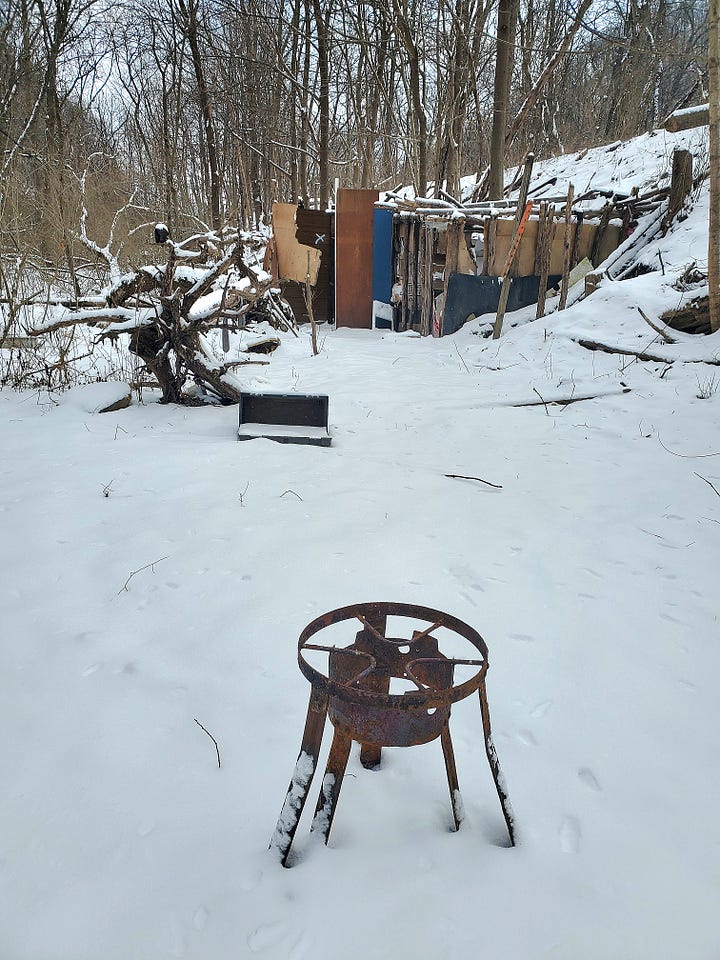

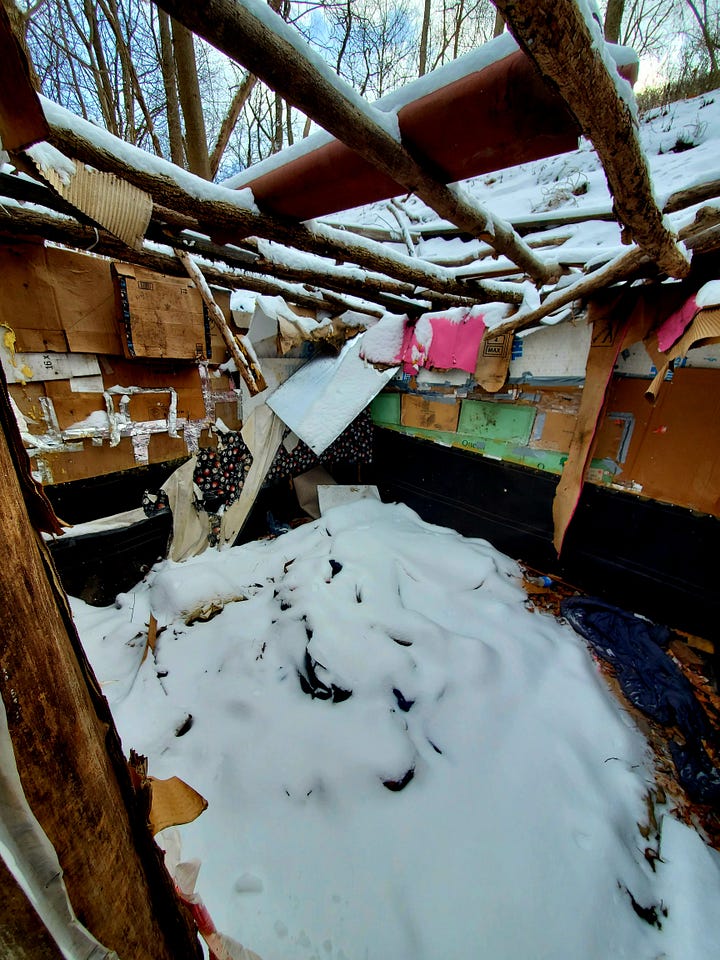
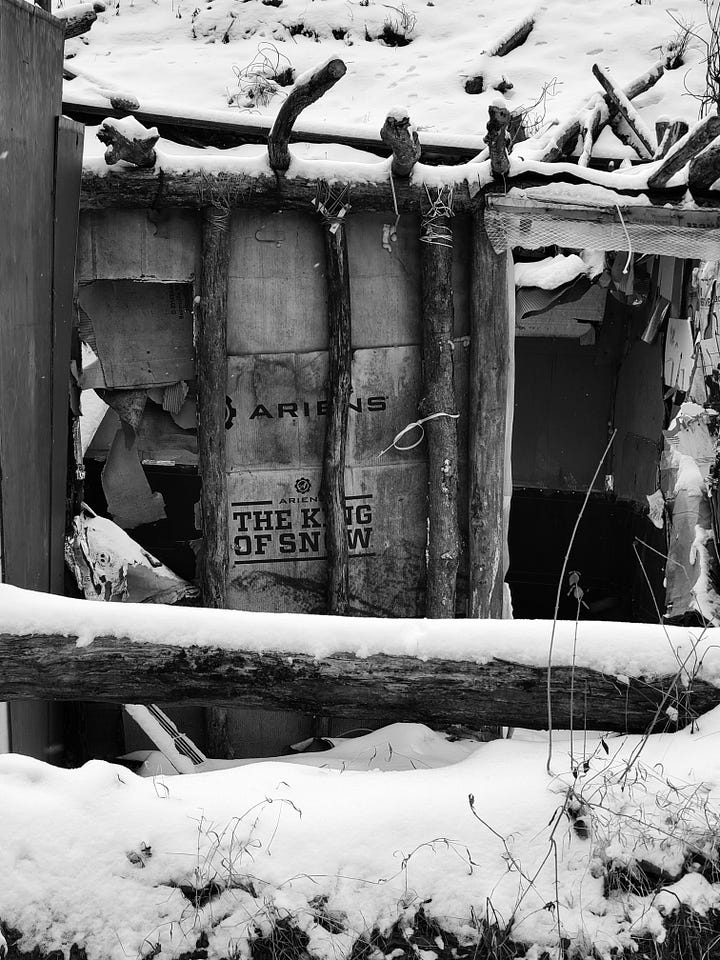
The King of Snow
On Wednesday the 8th, as soon as I’m back, I hit the Little Juniata and railroad pond again, but there’s nothing new, and the pond is frozen and lifeless. Bald Eagles are still mysteriously missing, and raptor-wise the most I can rustle up the rest of the week is a single Red-tailed Hawk, rising in the frigid dawn air, briefly, above the interstate. The river is freezing bit by bit, and juncos are now hopping about on the ice, pecking at seeds and other specks.
The hermits’ lair in terra nullius, tucked up against the old railroad trestle, has fallen into some disrepair. Indeed, the fall and winter have been blessedly abandoned down here in the lowlands—better for the birds.
In town, American Robins and European Starlings are about, with both species singing and starlings imitating species that either aren’t around or aren’t singing, like Killdeer and cardinals.
Meanwhile, Mom has already seen the Sharp-shinned Hawk terrorizing the gluttons around the feeder, and on Friday morning, we all received a shouted email from her, with the header “RUFFED GROUSE.” For the first time in many years, she’s seen one, and the good news is it was just up at the top of Guest House Trail along Laurel Ridge. I would guess it’s one of last year’s brood that Eric and Dave regularly come upon up there, though Mom’s sighting is the closest yet to the house.
Arrival of the Horde
On Saturday the 11th I’m glued to the computer, but as the morning grows I hear muffled clucking and crowing from the fruit trees outside the window that line Pennsylvania Avenue. Pepe sits enthralled in his window side tower, his head on a swivel, as hundreds of starlings and dozens of robins breeze from tree to tree. It has begun! Every winter at this time, presumably once better food supplies are gone, both species pour into town and begin to strip the fruits, a process that takes several days.
Eventually, work done, I head out along the tracks to perform my due diligence on the still patches of river. It’s in the 20s, as it’s been every day for awhile, and there’s an inch of fresh snow and more ice on the river. Not much is happening until I reach the bridge, flushing the year’s first Belted Kingfisher, which rattles off upriver. Still no Bald Eagle, and the herons and merganser have been gone since the first, but at least something’s after the fish.
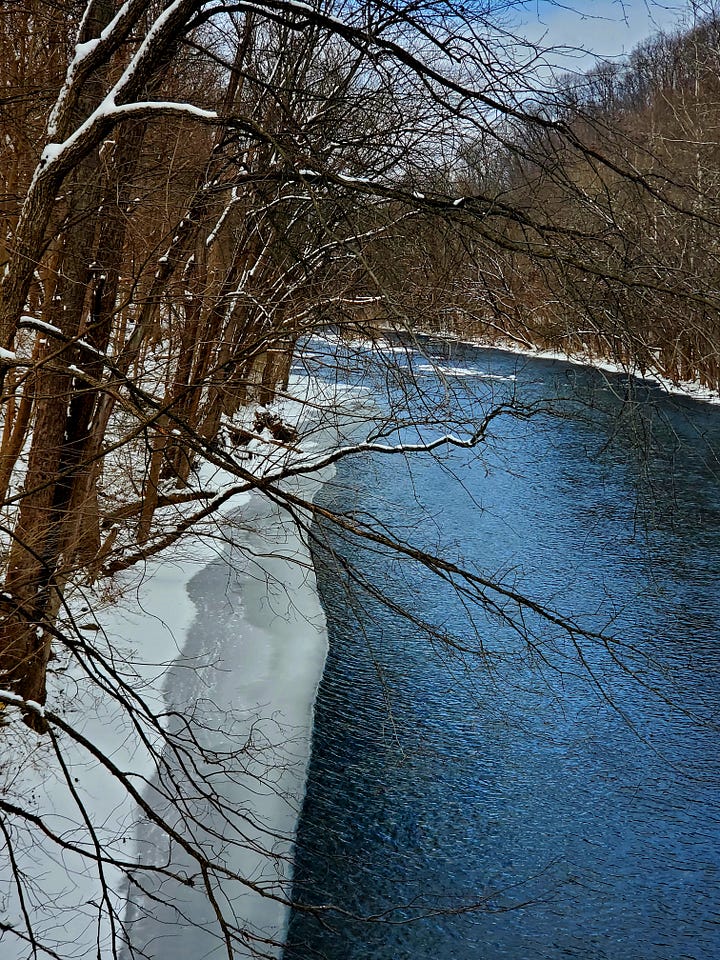

A few Mallards putter around in the water below the old railroad bridge pilings. I continue down the tracks to check the other stretch of calm-ish water, and spot a couple of small waterfowl swimmingly agitatedly. They take off almost immediately and fly right past me upstream: the best views I’ve ever had of Hooded Mergansers here, and the only time I’ve seen a male and female together. They don’t seem to like the constant highway and train noise—this is also the first time I’ve ever seen the species on the river. The last two years, I’ve seen a single female flee from the railroad pond in fall, and the only other record is of a male in flight with a flock of Common Mergansers.
I wasn’t planning to go up the Hollow today, but energized by this stroke of luck, I start the slog. I’m out of shape, and the gear is weighing me down; I’ll pay for it later. Nothing else new turns up, however, but at least I find a second spot for Hermit Thrush. Back in town, the trees behind the balcony are starling-coated: some 400 at least. The fruits won’t last long!
On Sunday, I’m out again along the tracks, flushing flocks of juncos from the weeds. An odd tableau emerges as I approach the bridge. To my left, the Belted Kingfisher flies from the bank up into a nearby tree as a Winter Wren scoots across the water and under a rock. A handful of American Crows flap off, cawing, but another, more unusual bird catches my eye as it hatches behind a willow in the narrow strip between the river and highway 453. Strangely enough it’s a Pileated Woodpecker, which I’ve never seen in this spot before. It take off, cackling loudly, and another swoops down from Bald Eagle Mountain, which rises straight from the highway; they head off upriver and then into terra nullius.
At the same time, below the bridge, two birds are out on an ice shelf, presumably juncos, the only species I’ve seen that has figured out how to forage there. But instead, one turns out to be a Hermit Thrush, oddly oblivious to me and to the highway above. The junco is a past master at navigating the slippery surface, but the thrush, inches away from it, is having some difficulty standing up as it tries to peck for whatever is out there. I have to think this unusual behavior is evidence of a certain avian desperation in the face of ever-dwindling resources.
Around the same time, Eric’s PUC recorded picks up the unmistakable mew of a Yellow-bellied Sapsucker. This confirms my suspicion that, like last January, one hangs about in the Sapsucker Ridge woods, even though it is nearly impossible to find. This puts the January total at a respectable 43 species.
Tuesday the 14th is frigid, 15 dropping to 13 with a brisk wind along the tracks. Last night, the Moon nearly collided with Mars; this morning, the Moon is on the opposite side of the sky, setting in the west.
A Mallard flies over at 7:05 AM, and before the quarter-hour, cardinals, juncos, and White-throated Sparrows are already out and about, easily seen and close to the tracks as they begin the search that becomes more desperate every day. As usual, the only birds flying high at dawn are crows and ravens; the weather seems too fierce for most of the rest, though occasionally, a goldfinch or House Finch flight call can be heard.
The river is clogged with ice now. Nothing is moving around the bridge, and the crows have returned to the tracks. A car rushes up to the crossing and parks just shy; two disheveled addicts, huddled, are too busy lighting a meth pipe to notice or care about me. Not much else is happening; my feet beginning to freeze, I tramp back to town. It looks like a warm-up into the 30s will happen this weekend—a veritable January thaw—followed by below-zero temperatures next week.
